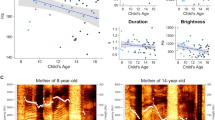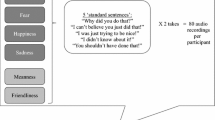Abstract
Audiotapes of the voices of77 preschool children were prepared. Subjects listened to the tapes, and then provided their impressions of the competence, leadership, dominance, warmth, and honesty of the children. Judgments of the voices' babyishness and attractiveness were also obtained. Perceivers reliably discriminated the children's voices along the dimensions of babyishness and attractiveness. Moreover, analyses revealed that the previously documented impact of these characteristics on first impressions of adults extends to impressions of young children. The similarity of the effects of these characteristics on impressions formed about children to those revealed for adults suggests that vocal qualities may have an impact on personality development via a process of self-fulfilling prophecy.
Similar content being viewed by others
References
Berry, D. S. (1990). Vocal attractiveness and vocal babyishness: Effects of stranger, self, and friend impressions.Journal of Nonverbal Behavior, 14, 141–153.
Berry, D. S. (1991). Accuracy in social perception: Contributions of facial and vocal information.Journal of Personality and Social Psychology, 61, 298–307.
Berry, D. S. (1992). Vocal types and stereotypes: Joint effects of vocal attractiveness and vocal maturity on person perception.Journal of Nonverbal Behavior, 16, 41–54.
Berry, D. S., & Finch Wero, J. L. (1993). Accuracy in face perception: A view from ecological psychology.Journal of Personality, 61, 497–520.
Berry, D. S., & Hill, E. (1994).Physical appearance, speech, and behavior as predictors of social perception. Paper presented at the meeting of the Midwestern Psychological Association, Chicago, IL.
Berry, D. S., & McArthur, L. Z. (1986). Perceiving character in faces: The impact of age-related craniofacial changes on social perception.Psychological Bulletin, 100, 3–18.
Cunningham, M. R. (1986). Measuring the physical in physical attractiveness: Quasi-experiments on the sociobiology of female facial beauty.Journal of Personality and Social Psychology, 50, 925–935.
Dion, K. K., Berscheid, E., & Walster, E. (1972). What is beautiful is good.Journal of Personality and Social Psychology, 24, 285–290.
Langlois, J. H. (1986). From the eye of the beholder to behavioral reality: Development of social behaviors and social relations as a function of physical attractiveness. In C. P. Herman, M. P. Zanna, & E. T. Higgins (Eds.),Physical appearance, stigma, and social behavior. (pp. 23–51). Hillsdale, NJ: Erlbaum.
Langlois, J. H., Roggman, L. A., Casey, R. J., Ritter, J. M., & Reiser-Danner, L. A. (1987). Infant preferences for attractive faces: Rudiments of a stereotype?Developmental Psychology, 23, 363–369.
Langlois, J. H., Roggman, L. A., & Reiser-Danner, L. A. (1990). Infant's differential social responses to attractive and unattractive faces.Developmental Psychology, 26, 153–159.
McArthur, L. Z., & Berry, D. S. (1987). Cross-cultural agreement in perceptions of babyfaced adults.Journal of Cross-Cultural Psychology, 18, 165–192.
Montepare, J. M.; & McArthur, L. Z. (1987). Perceptions of adults with childlike voices in two cultures.Journal of Experimental Social Psychology, 23, 331–349.
Montepare, J. M., & Zebrowitz-McArthur, L. (1989). Children's perceptions of babyfaced adults.Perceptual and Motor Skills, 69, 467–472.
Scherer, K. (1972). Judging personality from voice: A cross-cultural approach to an old issue in interpersonal perception.Journal of Personality, 40, 191–210.
Scherer, K. (1978) Personality inference from voice quality: The loud voice of extroversion.European Journal of Social Psychology, 8, 467–487.
Siegman, A. W. (1987). The telltale voice: Nonverbal messages of verbal communication. In A. W. Seigman & S. Feldstein (Eds.),Nonverbal behavior and communication, (pp. 351–434). Hillsdale, NJ: Erlbaum.
Zebrowitz, L. A., & Montepare, J. M. (1992). Impressions of babyfaced individuals across the life-span.Developmental Psychology, 28, 1143–1152.
Zebrowitz, L. A., Olsen, K., & Hoffman, K. (1993). Stability of babyfacedness and attractiveness across the life span.Journal of Personality and Social Psychology, 64, 453–466.
Zebrowitz-McArthur, L., & Montepare, J. M. (1989). Contributions of a babyface and a childlike voice to impressions of moving and talking faces.Journal of Nonverbal Behavior, 13, 189–203.
Zuckerman, M., & Driver, R. E. (1989). What sounds beautiful is good: The vocal attractiveness stereotype.Journal of Nonverbal Behavior, 13, 67–82.
Zuckerman, M., Hodgins, H. S., & Miyake, K. (1990). The vocal attractiveness stereotype: Replication and elaboration.Journal of Nonverbal Behavior, 14, 97–112.
Zuckerman, M., Miyake, K., & Hodgins, H. S. (1991). Cross channel effects of vocal and physical attractiveness and their implications for interpersonal perception.Journal of Personality and Social Psychology, 60, 545–554.
Author information
Authors and Affiliations
Rights and permissions
About this article
Cite this article
Berry, D.S., Hansen, J.S., Landry-Pester, J.C. et al. Vocal determinants of first impressions of young children. J Nonverbal Behav 18, 187–197 (1994). https://doi.org/10.1007/BF02170025
Issue Date:
DOI: https://doi.org/10.1007/BF02170025




